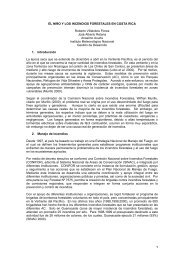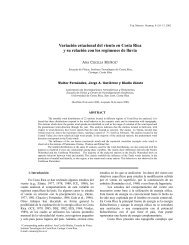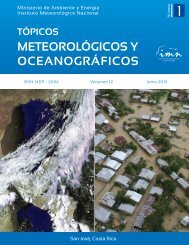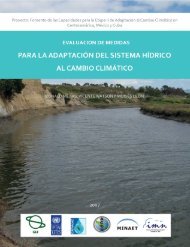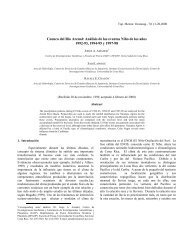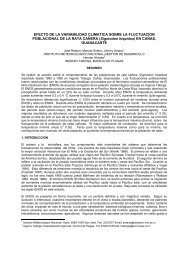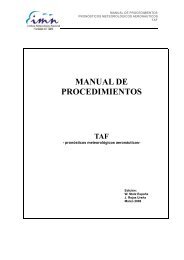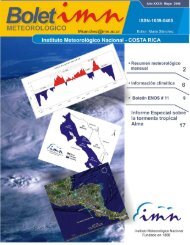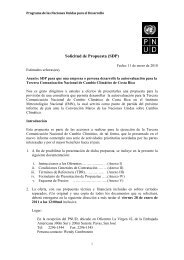descargar Documento - IMN - Instituto Meteorológico Nacional
descargar Documento - IMN - Instituto Meteorológico Nacional
descargar Documento - IMN - Instituto Meteorológico Nacional
Create successful ePaper yourself
Turn your PDF publications into a flip-book with our unique Google optimized e-Paper software.
20<br />
Policies, adopted measures<br />
and proposals for mitigation of<br />
greenhouse gas emissions<br />
Current domestic policies and guidelines for<br />
emissions mitigation along with the country’s<br />
goal towards carbon neutrality provide explicit<br />
recognition to the internalization of an economic<br />
policy in the national environmental policy.<br />
This policy incorporates in the energy bill, economic<br />
benefits obtained from renewable energy<br />
sources, as well as reduction and avoidance of<br />
an important quantity of greenhouse gas emissions<br />
(GHG) that will have been release otherwise<br />
in a base scenario. In addition, the policy<br />
internalizes and promotes a transport sector<br />
based on renewable energy, since more than<br />
60% of GHG emissions derive from the use of<br />
fossil fuels from transportation activities.<br />
Another innovator policy element is the internal<br />
scheme that provides incentives to national<br />
companies and producers to move forward in<br />
the process for technological research and development<br />
to reduce emissions in relation to each<br />
production unit. This will be accomplished by<br />
designing a local market for net emission reductions<br />
that could be purchased by those who did<br />
not achieve their emission goals. According to<br />
this scheme, holders of verified net credits could<br />
allocate them with those that exceed their net<br />
emission balance. This scheme will enter into effect<br />
progressively in order to promote the process<br />
and move towards the goal of carbon neutrality.<br />
This scheme of a policy for emission reduction<br />
and preparation to climate change that includes<br />
projects of second generation present the opportunity<br />
to incorporate all type of ecosystems with<br />
capacity to capture and fix GHG emissions. This<br />
will allow a broader scope beyond the forestry<br />
sector through the Payment for Environmental<br />
Services (PES) that demonstrates disproportionate<br />
distribution by the concentration of income<br />
in a few extensive landowners.<br />
Reduced emissions will allow generation of<br />
economic incentives and markets to increase<br />
authorized emission reduction transactions<br />
among those holders which net emission balance<br />
is negative. This will promote trading and<br />
generation of economic incentives and will encourage<br />
technological changes to technologies<br />
that will make possible to achieve the goal of<br />
carbon neutrality, through best production practices<br />
and energy generation from renewable<br />
sources and less emitter of GHG emissions.<br />
Proposed measured are established for individual<br />
sectors and well as crosscutting links to<br />
develop national policies. In addition to guidelines,<br />
areas, measures and proposals, there is a<br />
list of main projects in order to move towards<br />
GHG mitigation to address climate change and<br />
advance to C-neutrality. These issues are closely<br />
related to mitigation technologies and GHG<br />
emission reductions.<br />
Costa Rica has designed these policies in recognition<br />
to its unilateral declaration of carbon<br />
neutrality announced internationally. Therefore,<br />
these policies respond to the national commitment<br />
to fulfill its international position and they<br />
are not isolated initiatives aimed at merely satisfying<br />
a requirement to the UNFCCC. On the<br />
contrary, these policies will generate an effective<br />
scheme for the country’s strategy that will be<br />
enabled by the appropriate mechanisms for its<br />
coordination, implementation and monitoring.<br />
GHG Mitigation Options to Achieve<br />
Carbon Neutrality in 2021<br />
In order to define a portfolio of mitigation projects<br />
and efforts towards the national goal of<br />
carbon neutrality, sectors must consider that the<br />
national economy requires to increase production<br />
of energy from renewable sources and to<br />
reduce dependence on fossil fuels. According<br />
to the results and previous estimations, energy<br />
production from hydrological sources presents<br />
II Comunicación <strong>Nacional</strong> 2009



